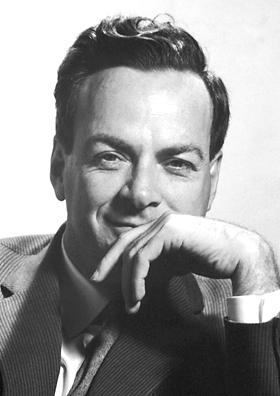Richard Feynman was a legendary physicist last century. To the popular mass, he was ( and is still) famous for his science popularizer books such as “What do you care what other people think?“, “Surely you’re joking, Feynman!“, “The pleasure of finding things out” and others. He was also an investigator of the Challenger disaster, with his famous TV demonstration of how the material used in shuttle O-rings became less resilient in cold weather and hence led to the disaster.

To his colleagues, he was a nobel prize winner in 1965, for his contribution to the development in Quantum Electrodynamics ( QED) and his Feynman diagram, a graphical way to calculate the probability amplitude of the interaction of subatomic particles. Feynman diagram is still widely used in high energy physics, it’s a method that is favored over other equivalent but arcane and tedious mathematical formalism.
Even though Feynman worked in an arcane and hugely intellectual demanding field, but the books he wrote for the mass give us a glimpse into his thinking method and jocular, playful character. It would be useful to summarize here how he used to think and his learning method in a way that benefits me ( and everyone who reads this post).
One thing that stands out for Feynman is the topic of How do you learn? A lot of us start and stop with memorizing names, because that was the thing that the school taught us. Just memorize the names on the textbooks, and you can score A in exam! Rote memorization is a destroyer of creativity, and a poor approximation to the actual learning progress. Such a dry, rote memorization surely turned Feynman off, for it didn’t enhance understanding at all; for all you learn is just names, which is meaningless by itself.
To properly learn a concept, you have to be able to understand it, explain it using a simple example and with your own language. Repeat this until you are able to explain this to a 8 year old kid. The last step is important, because it forces you to strip away all the pretentious and bombastic jargons ( for too many ignorance hide behind jargons), and focuses on the bare essence.
Let’s take one simple example ( that I think of on the fly): “What is a tiger”?
The tiger (Panthera tigris) is the largest extant cat species and a member of the genus Panthera. It is most recognisable for its dark vertical stripes on orange-brown fur with a lighter underside. It is an apex predator, primarily preying on ungulates such as deer and wild boar. It is territorial and generally a solitary but social predator, requiring large contiguous areas of habitat, which support its requirements for prey and rearing of its offspring. Tiger cubs stay with their mother for about two years, before they become independent and leave their mother’s home range to establish their own.
Obviously, such dry explanation is not beneficial to anyone, let alone a 8 year old kid. So how can you make a kid understand what a tiger is, assuming that you can’t show him photos or videos?
Here’s my take:
A tiger is just a like a cat, but much bigger in size. Like cat it also eats meat and vegetable. Like a cat, it also has colorful stripes. But unlike cat, because its size is bigger, it doesn’t eat lizard or mouse, it eats other big animals like deer or boar and sometimes, even human being!
A student who memorizes the wikipedia answer will get an A in exam, but someone who can come up with the second is someone who really understand what a tiger is.
Feynman is also known with his superb teaching ability, and his ability to mix around with his students. He declined a job offer from The Advanced Institute of Princeton, the same Institute that housed scholars like Einstein. At the Institute, the professors were not distracted by teaching duties, so that they could concentrate on research the whole time. But Feynman dreaded this kind of arrangement, claiming that it deprived him of the inspiration that could only come from the interaction with the students. Students asked innocent questions and provided new angles to approaching old problems. Isolated from them was tantamount to being cut off from the spring of ideas.
Feynman lived a live that is fully idiosyncratic and unconventional. He learnt to draw when he was already well-established as a theoretical physicist, and sold his drawing using a pseudonym. He was also an amateur musician like Einstein, and often played bongo and conga drums in the pit orchestra in musicals. To the great horrors of his colleagues, he opened up safe– just for the fun of it– while working at the top secret Manhattan project at Los Alamos. He didn’t appear to care so much about his reputation, his statue, his “standing” at all.
“What do you care what other people think?” was a rhetorical question that Feynman first wife asked him while she was dying on her deathbed, to goad him to get on with his life and stop worrying: just be your truest self and don’t overthink, you are not as important as you think you are. Feynman did live a life that perfectly encapsulated this spirit. It would not be an overstretch to say that in this case, an important question shapes the life of a very important man.
I guess all of us have a little Feynman in our heart. Every single child that comes into this world is inquisitive, and derives pleasure from sharing knowledge. Children want to try different things, different characters in lives. But then, as they grow up, society expectation piles up on them, and somehow it diminishes their inquisitiveness and ability to try new things. “What do other people think of me?” often holds us back from our potential; we are afraid to ask questions because we don’t want to appear stupid, we don’t dare to venture into new area because we are afraid of failures. So much damages can be done from an imaginary question! Feynman life should inspire us to remain true to ourselves and convince us that retaining our childlike wonder can lead to a more colorful and meaningful life, regardless of what other people think.





